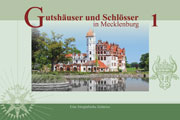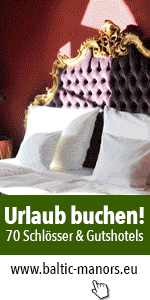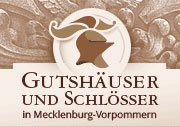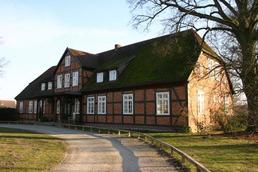Deutsche Website
Book "Manor houses and castles in Mecklenburg"

In Volume 1, we present 49 estates on 156 pages with short texts and more than 220 historical and current photographs.
Woldzegarten Manor House
Woldzegarten lies about 16 kilometers (10 miles) northwest of Röbel, picturesquely nestled between Ice Age hills and swampy lowlands along Tangahn Lake.
The name comes from the Slavic and means roughly "the fort that lies on the forest lake." Woldzegarten even lies between two lakes and was therefore always difficult to reach and easy to defend. The remains of an old Slavic fortress wall still stand.
In 1477 Andreas v. Flotow took over the lands around Woldzegarten. His family had built a castle-like fortification in the nearby marshy area of Stuer as its seat. The many-branched von Flotow family was the owner of the Woldzegarten estate without interruption until 1945. During the Thirty Years' War the widow Anna von Flotow had to mortgage the Woldzegarten property. In 1736 the estate came to Adam Ernst von Flotow of Kogel. In 1794 Georg Dietrich von Flotow inherited the estate during the lifetime of his father Adam Philipp M. along with Walow and Grüssow. In 1899 Hans Dietrich E. Adam A. K. von Flotow was the owner of Woldzegarten. The estate belonged to the Lübz tax district for enfeoffed property. In 1921 Hans von Flotow was the owner and Mr. Kasten the lessee of the 780-hectare (1900-acre) fief. At this time there was a narrow-gauge connection to the Ganzlin-Röbel railroad line.
Hans von Flotow died in 1936. Since his son was only four years old, his mother turned over the management of the estate to Mr. Wichmann, who had already worked on the property for some time. She herself lived in Walow. In 1945 Frau von Flotow was banished to Woldzegarten by the Soviet military and later turned out of the area altogether. Mr. Wichmann was dragged off to the concentration camp at Fünfeichen near Neubrandenburg, where he died.
The vaulted cellars are much older than the current manor house and probably even older than the previous building. It is assumed that they date from the 15th century. An underground escape route to Tangahn Lake dating from this period is supposed to have been discovered during restoration work. In 1738 the manor house burned.
The von Flotow family had the current half-timbered building built over the fieldstone foundation on 11 axes. A central bay with three axes adorns the front of the house. At the back of the house the façade was plastered over during repair work under the East German regime, but the projecting central bay is half-timbered and the hipped roof has been repaired. After 1945 communal facilities such as the municipal office, kindergarten, and cooperative store were accommodated in the house. Dwellings for refugees were also incorporated.
After 1990 the estate grounds increasingly decayed. In 1996 the ensemble was acquired by Dr. Wolfgang Droll of Berlin. After gutting, the house was reconstructed to historic preservation standards with authentic materials, thus regaining its original splendor. Because of its restoration and tranquil location it is today a popular hotel and excursion site. The house and the wood-clad addition on its east side contain a total of 20 guest rooms as well as a pool, a cosmetic salon, and a fitness area in the splendid events barn.
The estate grounds include a large barn whose ground floor still housed livestock during East German times. Above is a huge expanse for hay and straw as well as a three-storey grain storehouse. With its 900 square meters (9700 square feet) this barn is not only one of the largest in Mecklenburg, but its hayloft is also an example of the traditional Carpenter Gothic style. With careful preservation of its original structure it was converted to a 600-person concert and event venue in 1999-2000. Every year symphonic concerts and music competitions take place here. The upper floor of the grain storehouse is equipped for seminars and workshops.









